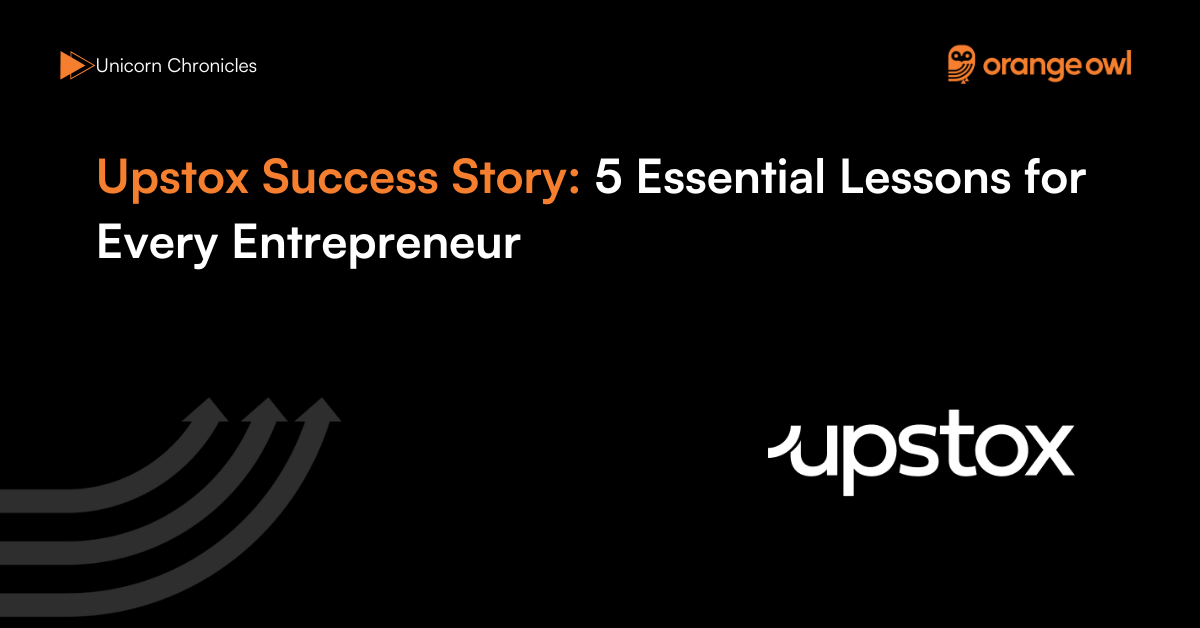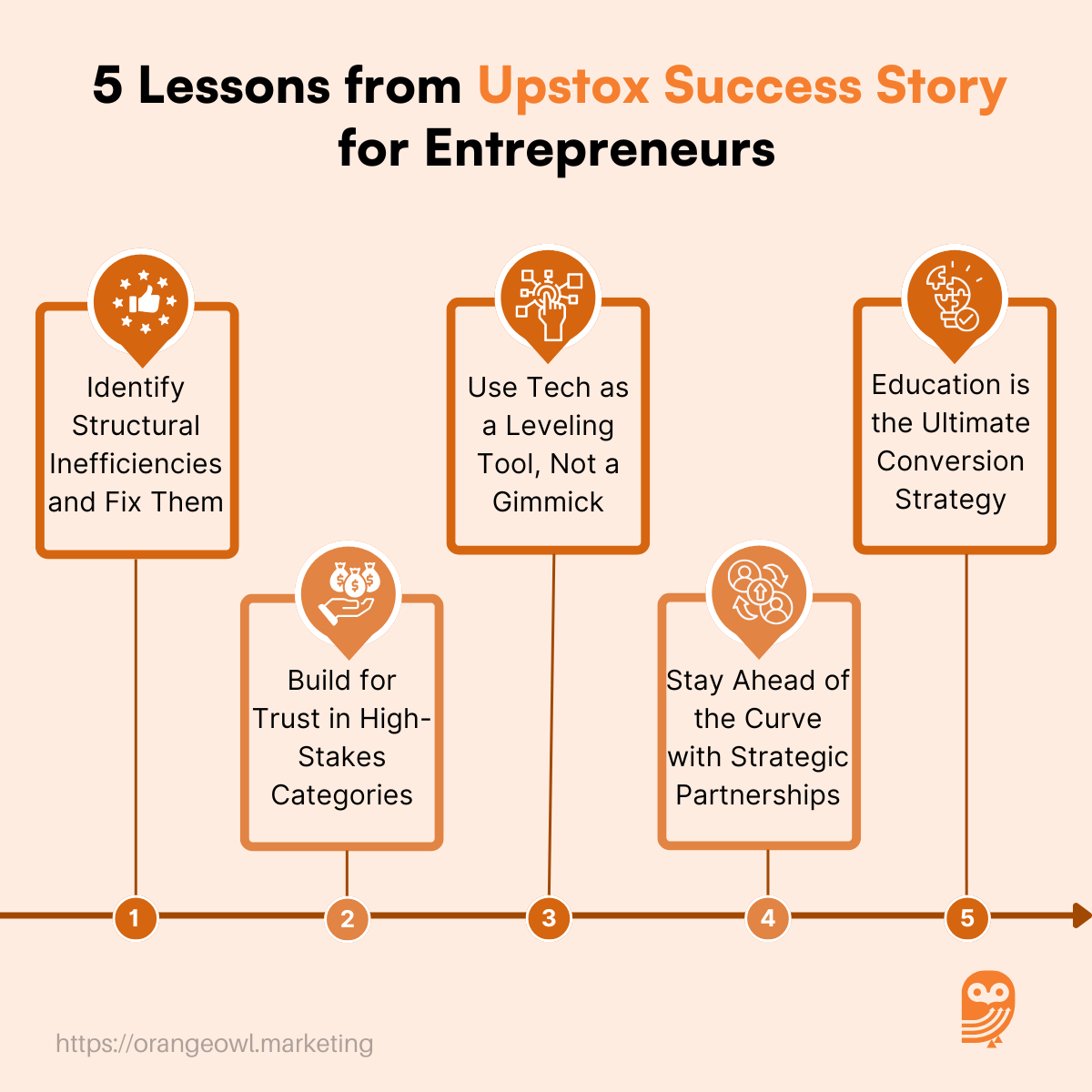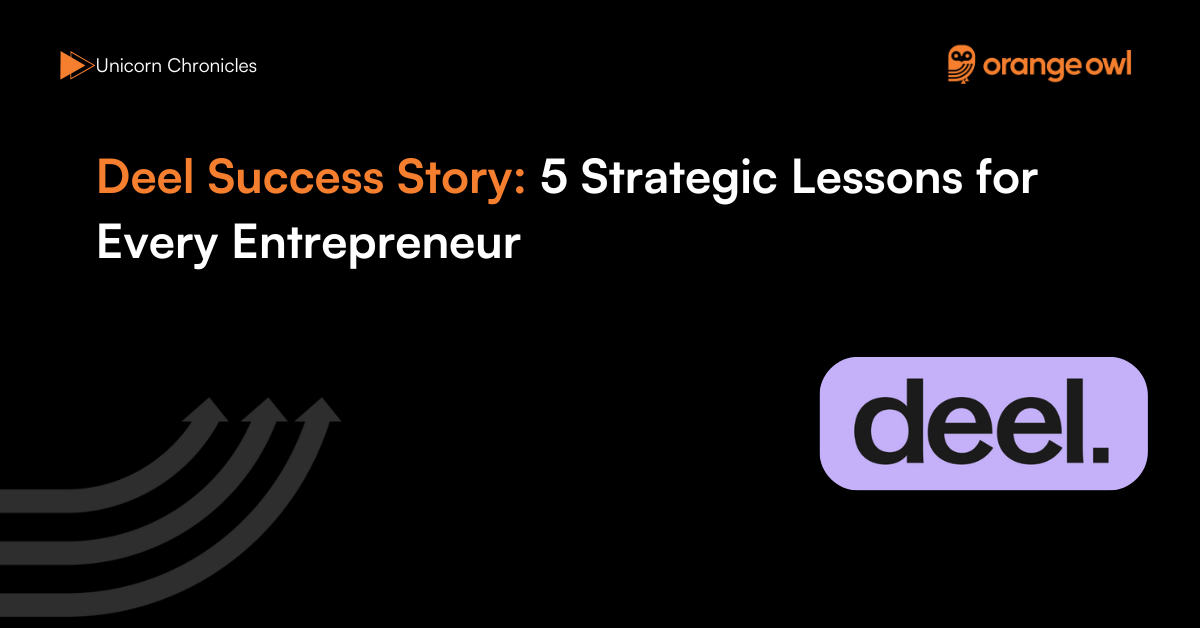Upstox Success Story: 5 Essential Lessons for Every Entrepreneur
Vivek Goel
May 5, 2025

Table of Contents
Introduction
In India’s rapidly evolving financial landscape, Upstox has emerged as a leading discount brokerage platform, democratizing access to capital markets. Co-founded in 2009 by Ravi Kumar, Shrini Viswanath, and Kavitha Subramanian, Upstox has broken the barriers of high brokerage fees and technical complexity, empowering millions of Indians to invest in stocks, mutual funds, and IPOs with ease. Backed by prominent investors such as Tiger Global and Ratan Tata, Upstox is not just a fintech startup—it’s a movement that has helped bring retail investing into the mainstream.
“We wanted to simplify investing and make it available to every Indian, not just the elite.” — Shrini Viswanath, Co-founder of Upstox
Upstox’s journey is a testament to vision, timing, and persistence. By 2024, the platform reported a revenue of ₹1,311 crore for FY24, marking a 25% increase from the previous year, and achieved a net profit of ₹190 crore, an eightfold surge from ₹25 crore in FY23 . With approximately 17 million registered users, 85% of whom hail from tier-two and tier-three cities, Upstox has significantly expanded financial inclusion across India . The company’s focus on technology-driven solutions and user-centric design has made investing accessible to a broader demographic, positioning Upstox as a pivotal player in India’s fintech revolution.
Origin Story
Upstox’s journey began in 2009, when three entrepreneurs—Ravi Kumar, Shrini Viswanath, and Shrinivas Viswanath—founded RKSV Securities. The name RKSV was derived from the initials of the co-founders, symbolizing a deeply personal mission: to change the way India trades. At the time, retail investing in India was restricted to a privileged few who could afford steep brokerage fees and navigate clunky, outdated interfaces. This lack of accessibility was a glaring gap the founders aimed to address.
“In the U.S., anyone could open a brokerage account and start investing. We wanted to bring that level of accessibility to India.” — Ravi Kumar, Co-founder of Upstox
With this global inspiration in mind, RKSV started as a bootstrapped venture offering low-cost trading solutions, initially catering to active traders who were price-sensitive. Over time, the team realized that the real opportunity lay in empowering the masses, not just day traders. This insight led to a transformation in their approach—from serving a niche user base to developing a full-fledged digital platform that could scale nationwide.
By 2016, this evolution culminated in a major rebranding. RKSV became Upstox, signaling a fresh, tech-forward identity that resonated with India’s burgeoning mobile-first, app-savvy generation. With smartphones becoming ubiquitous and Jio revolutionizing internet access, Upstox was perfectly positioned to ride the wave of digital inclusion. Their platform was redesigned to prioritize user experience, offer seamless onboarding, and simplify the complex world of stock trading for new-age investors.
What set Upstox apart was its dual commitment to affordability and usability. They launched zero brokerage plans on equity investments and kept trading costs exceptionally low, making them a preferred choice for cost-conscious retail investors. The name Upstox soon became synonymous with empowerment—giving people from Tier 2 and Tier 3 cities a seat at the table of India’s financial future.
Business Landscape and Early Challenges
When Upstox entered India’s stockbroking ecosystem, it was stepping into a sector that was not only intensely competitive but also rooted in legacy systems and long-standing customer relationships. Traditional brokerage firms had built decades of brand equity, especially among older investors who were accustomed to offline support and full-service models. For a young, mobile-first company like Upstox, breaking into this tightly held space meant facing both perceptional and operational headwinds.
“Our biggest challenge was building credibility in a space that revolved around money and trust.” — Kavitha Subramanian, Co-founder of Upstox
At the heart of this challenge was trust. Convincing users—especially first-time investors—to entrust their hard-earned money to a digital platform required more than just sleek design. It demanded an unwavering commitment to transparency, seamless execution, and constant uptime. Any glitches in trade execution or delays in customer service could immediately erode confidence. That’s why, in the early years, the Upstox team devoted substantial resources to building a robust backend infrastructure that could withstand high trade volumes and offer institutional-grade reliability.
Regulatory hurdles posed another steep learning curve. Operating in a space governed by SEBI (Securities and Exchange Board of India), Upstox had to ensure complete adherence to compliance standards, KYC protocols, and audit trails. They also needed to align with data protection regulations and cybersecurity best practices to protect sensitive financial information.
“We took a lot of pain to make our tech robust. Trust in fintech comes from stability, not just fancy UI.”— Shrini Viswanath, Co-founder of Upstox
Despite these barriers, Upstox never lost sight of its mission: to democratize investing. One of its most pivotal strategic decisions was to offer zero brokerage on equity delivery trades—a move that not only disrupted industry pricing models but also attracted a wave of price-sensitive users. This aggressive pricing strategy, paired with a slick mobile app and fast onboarding process, began shifting the tide in Upstox’s favor.
The team’s resolve was further tested during peak market events like IPO booms and volatile trading days, which tested the platform’s scalability. Yet, Upstox continued to improve and invest in cloud-native architecture, high-frequency APIs, and scalable customer support systems to deliver a consistent and dependable user experience.
In a market that historically catered to the privileged few, Upstox managed to carve a niche by putting accessibility, affordability, and user trust at the center of its operations. The journey from being a little-known discount brokerage to one of India’s largest trading platforms is a testament to its resilience and clarity of vision.
Growth Strategies
Upstox’s meteoric rise wasn’t just a result of India’s growing interest in financial markets—it was a masterclass in strategic execution and timely innovation. While the COVID-19 pandemic prompted a global digital shift, India saw an unprecedented surge in retail investors entering the stock market. Upstox was perfectly positioned to capitalize on this moment. From less than 1 million users in early 2020, the company skyrocketed to over 11 million users by 2023, making it the second-largest stockbroker in India after Zerodha, according to.
Central to this growth was Upstox’s obsession with product simplicity. The app was designed to be mobile-first, low-friction, and tailored to new investors who had little to no prior experience. Users could sign up, complete KYC, and start trading within minutes. The platform’s zero-brokerage policy on equity delivery and low-cost intraday trading made investing accessible to millions, particularly college students, gig workers, and young professionals looking to make their first trade.
But Upstox didn’t stop at affordability—it scaled its product features to meet the needs of both novice and advanced traders. The platform introduced Smart Lists, a curated set of trending and thematic stocks to guide user decisions, and Pro Web, a high-speed trading terminal for experienced traders who wanted more control and analysis tools. They further extended support for derivatives, mutual funds, IPO applications, and SIPs—all accessible from a single app interface.
Recognizing the linguistic and cultural diversity of India, Upstox expanded its app’s interface into multiple regional languages, ensuring penetration beyond urban centers. This inclusivity played a crucial role in attracting users from Tier 2 and Tier 3 cities, a segment often overlooked by traditional brokerages.
In 2021, Upstox entered the unicorn club after a funding round led by Tiger Global, joining India’s elite group of billion-dollar startups. This valuation milestone reflected not just the company’s user growth but the scalability and robustness of its technology infrastructure and revenue model.
“Tech has to scale with simplicity. Our goal was to give a smooth experience, whether you’re a college student or a full-time trader.” — Ravi Kumar, Co-founder of Upstox
Marketing Strategies
Upstox’s marketing approach has always revolved around demystifying stock trading for the average Indian. Unlike legacy financial brands that leaned on jargon and exclusivity, Upstox opted for humor, relatability, and clarity in its communication. This tone helped break the psychological barrier that “investing is only for experts.”
Their digital campaigns on Instagram, YouTube, and Google Search were tailored for Gen Z and millennial audiences, often using finance influencers to explain complex topics like options trading, compounding, and tax-saving instruments in easy-to-digest formats. Collaborations with creators like Pranjal Kamra, CA Rachana Ranade, and other personal finance educators became a powerful funnel for onboarding new users.
A major breakthrough came with their official partnership with the Indian Premier League (IPL)—one of the most-watched sporting events in India. As the Official Partner of IPL from 2021, Upstox gained national visibility, reaching millions of cricket fans across urban and rural markets. This strategic association helped them transcend the digital bubble and create strong offline brand recall.
The company also leveraged gamified referral programs, incentivizing users to invite friends and family by offering free trades or rewards. This organic word-of-mouth growth engine was supported by in-app educational content, including blogs, videos, and real-time simulators. These tools helped first-time investors build confidence, turning them into loyal and repeat users.
In a sector where trust is paramount, Upstox’s consistent investment in educational marketing set it apart. While others focused purely on acquisition, Upstox focused on empowerment—building an ecosystem where users could learn, explore, and grow.
By combining low-cost access, powerful product design, and cultural relevance, Upstox didn’t just grow a user base—it cultivated a movement toward financial inclusion.
5 Essential Lessons Every Entrepreneur Should Learn from Upstox
1. Identify Structural Inefficiencies and Fix Them
Upstox didn’t succeed by inventing something new—it thrived by fixing what was broken. Traditional brokerages in India were mired in high fees, complex interfaces, and a legacy mindset. Upstox entered the scene with a bold yet simple promise: remove the friction. By offering zero-commission trading and building an intuitive, mobile-first app, the platform flipped the brokerage model on its head. It allowed millions of young Indians to enter the capital markets without needing financial literacy or large capital.
“Our job was to make investing feel like ordering a cab—simple, fast, and affordable.”— Shrini Viswanath, Co-founder of Upstox
Entrepreneurs should take note: meaningful innovation often lies in simplifying outdated systems, not just adding new features.
2. Build for Trust in High-Stakes Categories
When your product revolves around people’s money, trust becomes your most valuable currency. Upstox understood that early and built a foundation of reliability, compliance, and transparent operations. From end-to-end encryption and real-time alerts to robust customer support and clear policies, every touchpoint was designed to build user confidence. Compliance with SEBI guidelines wasn’t just a checkbox—it was part of the brand promise.
As Co-founder Kavitha Subramanian emphasized, “Our biggest challenge was building credibility in a space that revolved around money and trust.”
This approach paid off. As of 2023, Upstox consistently ranks among the top brokers in terms of active client base on NSE, demonstrating that users not only signed up—but stayed.

3. Use Tech as a Leveling Tool, Not a Gimmick
In an era of tech hype, Upstox kept its focus on substance over flash. The founders knew that for first-time investors, the learning curve needed to be minimal. Their design choices prioritized usability and accessibility over complexity. They avoided the pitfall of adding excessive features that might alienate newcomers. Instead, they introduced meaningful tools—like Smart Lists for trending stock insights, Pro Web for advanced users, and regional language support for India’s diverse user base.
The takeaway? Use technology to remove barriers, not add layers. Innovation should expand access, not intimidate your users.
4. Stay Ahead of the Curve with Strategic Partnerships
Upstox’s marketing strategy wasn’t built solely on paid ads—it was powered by strategic partnerships that amplified credibility and brand visibility. Their partnership with the Indian Premier League (IPL) made investing feel cool, relatable, and aspirational. Suddenly, Upstox wasn’t just a trading app—it was your team’s official partner.
In parallel, Upstox built strong collaborations with finance influencers and educators across YouTube and Instagram, tapping into a grassroots network of trust. These voices helped Upstox reach Tier 2 and Tier 3 markets, where personal finance literacy is still evolving.
Entrepreneurs should recognize that partnerships can do more than scale visibility—they can shape perception and build emotional resonance.
5. Education is the Ultimate Conversion Strategy
Perhaps Upstox’s most underrated asset is its commitment to user education. The platform didn’t just offer trades; it taught users how to trade. With a content library that includes blogs, video tutorials, live sessions, and even simulated stock trading environments, Upstox created a learning ecosystem around its product.
This strategy turned casual visitors into confident users, and confident users into loyal advocates. By investing in education-led marketing, the brand built long-term customer relationships, not just app downloads.
This is a crucial lesson for entrepreneurs: in markets where users are still learning, your product must teach before it can sell.
Conclusion: Key Takeaways from Upstox’s Journey
The Upstox success story is a powerful case study in user-centric innovation, especially within a heavily regulated and competitive industry. What began as RKSV—an experiment to disrupt outdated brokerage models—evolved into a billion-dollar unicorn reshaping the way India invests. The founders’ focus on solving real problems, simplifying access, and earning trust every step of the way shows that you don’t always need to be first—you just need to be better and bolder.
“The future of investing is inclusive, intelligent, and driven by trust.” — Kavitha Subramanian, Co-founder of Upstox
For every aspiring entrepreneur, Upstox is a masterclass in how to scale with integrity. It proves that disruption is not just about shaking things up—it’s about rebuilding better systems for the people who’ve long been left out. Whether you’re building in fintech or any other domain, the fundamentals remain: solve for the user, build with empathy, and never lose sight of trust.


